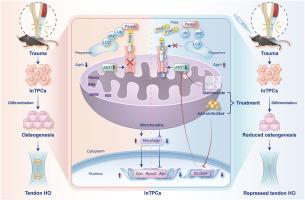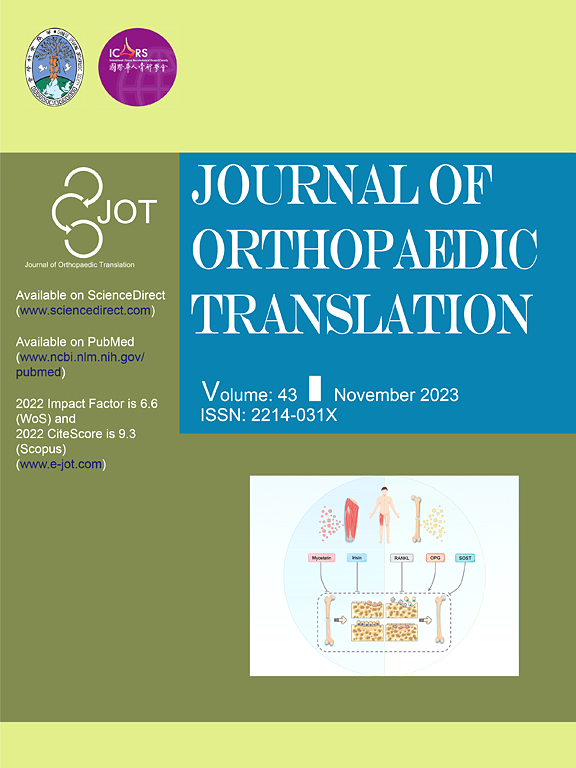靶向ANT1调控PINK1/ parkinson介导的线粒体自噬是治疗创伤性肌腱异位骨化的有效方法
IF 5.9
1区 医学
Q1 ORTHOPEDICS
引用次数: 0
摘要
背景异位骨化(HO)是创伤后常见的退行性疾病。肌腱HO主要归因于肌腱内干细胞/祖细胞的成骨分化。然而,这一过程背后的确切机制尚不清楚。最近的研究表明PTEN诱导的激酶1 (PINK1)/帕金森介导的有丝分裂在生物矿化中起着至关重要的作用。腺嘌呤核苷酸转位酶1 (ANT1)是PINK1/Parkin通路的上游调节因子,可能通过调节线粒体自噬来影响肌腱骨化的发展。方法在临床标本、小鼠组织和细胞中观察线粒体自噬在肌腱成骨中的作用。在体外和体内通过敲低溶质载体家族25成员4 (Slc25a4)来评估ANT1通过线粒体自噬调节肌腱成骨的影响。此外,通过计算机虚拟筛选和实验验证,确定了elamipretide是潜在的ANT1靶向药物。用小鼠细胞、组织和人细胞验证其对肌腱骨化的治疗效果。结果本研究发现,PINK1/ parkinson介导的线粒体自噬在肌腱骨化过程中被激活,线粒体自噬的调节可能影响损伤肌腱源性祖细胞(inTPCs)的成骨。Slc25a4基因缺失通过下调过度的有丝分裂抑制肌腱骨化。抗ANT1的靶向药物埃拉米普肽治疗HO疗效显著。结论通过靶向ANT1调节PINK1/ parkin介导的线粒体自噬可减轻创伤性肌腱HO的进展,表明ANT1可能是HO的潜在治疗靶点,而依拉米普肽有望成为治疗HO的药物。本研究确定了ANT1作为治疗靶点,并支持依拉米普肽作为HO的一种有前景的治疗策略。本文章由计算机程序翻译,如有差异,请以英文原文为准。

Targeting ANT1 to regulate PINK1/Parkin-mediated mitophagy is an effective treatment of trauma-induced tendon heterotopic ossification
Background
Heterotopic ossification (HO) is a common degenerative disease following trauma. Tendon HO is primarily attributed to osteogenic differentiation of stem/progenitor cells within the tendon. However, the precise mechanism underlying this process remains unclear. Recent studies suggest that PTEN induced kinase 1 (PINK1)/Parkin-mediated mitophagy plays a crucial role in biomineralization. Adenine nucleotide translocase 1 (ANT1), an upstream regulator of the PINK1/Parkin pathway, may influence tendon ossification development by modulating mitophagy.
Methods
This study investigated the role of mitophagy in tendon osteogenesis in clinical specimens, mouse tissues, and cells. The impact of ANT1 on tendon osteogenesis through mitophagy regulation was assessed by knocking down solute carrier family 25 member 4 (Slc25a4) both in vitro and in vivo. Furthermore, elamipretide was identified as a potential targeted drug for ANT1 through computer virtual screening and experimental verification. Its therapeutic efficacy on tendon ossification was validated using mouse cells, tissues, and human cells.
Results
This study found that PINK1/Parkin-mediated mitophagy was activated during tendon ossification, and the regulation of mitophagy could impact the osteogenesis of injured tendon-derived progenitor cells (inTPCs). Loss of Slc25a4 inhibited tendon ossification by downregulating the excessive mitophagy. Elamipretide, a targeted drug for ANT1, showed significant efficacy in treating HO.
Conclusion
Modulating PINK1/Parkin-mediated mitophagy by targeting ANT1 mitigated the progression of trauma-induced tendon HO, indicating ANT1 can be a potential therapeutic target for HO, with elamipretide emerging as a promising drug for its treatment.
The translational potential of this article
This study identifies ANT1 as a therapeutic target and supports elamipretide as a promising treatment strategy for HO.
求助全文
通过发布文献求助,成功后即可免费获取论文全文。
去求助
来源期刊

Journal of Orthopaedic Translation
Medicine-Orthopedics and Sports Medicine
CiteScore
11.80
自引率
13.60%
发文量
91
审稿时长
29 days
期刊介绍:
The Journal of Orthopaedic Translation (JOT) is the official peer-reviewed, open access journal of the Chinese Speaking Orthopaedic Society (CSOS) and the International Chinese Musculoskeletal Research Society (ICMRS). It is published quarterly, in January, April, July and October, by Elsevier.
 求助内容:
求助内容: 应助结果提醒方式:
应助结果提醒方式:


